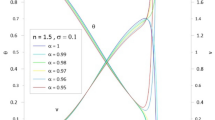Abstract
This paper studies polytropic gas spheres with some innovations. The main idea, already advanced in the context of neutral, homogeneous, polytropic stellar models, is to base the theory firmly on a variational principle. Another essential novelty is that the mass distribution extends to infinity, the boundary between bulk and atmosphere being defined by an abrupt change in the polytropic index, triggered by the density. The logical next step is to include the effect of radiation, which is a very significant complication since a full treatment would have to include an account of ionization, thus fields representing electrons, ions, photons, gravitons and neutral atoms as well. In way of preparation, we consider models that are charged but homogeneous, involving only gravity, electromagnetism and a single scalar field that represents both the mass and the electric charge; in short, a non-neutral plasma. While this work only represents a stage in the development of a theory of stars, without direct application to physical systems, it does shed some light on the meaning of the Reissner–Nordström solution of the modified Einstein–Maxwell equations. But the main point of the paper is a suggestion about the proper place of the photon gas in a theory of stellar structure and other plasmas, with an application to a simple system; it is proposed to treat the photon gas as part of the dynamics.
Similar content being viewed by others
References
Davidson R.C. (1989). Theory of Non-Neutral Plasmas. Addison-Wesley Pub. (Sd), Reading
Eddington A.S. (1960). The Internal Constitution of Stars, with a New Introduction by Lloyd Motz. Dover Publications, Inc., New York
de Felice F., Yu Y. and Fang J. (1995). Relativistic charged spheres. Mont. Not. Astr. Soc. Lond. 277: L17
de Felice F., Liu S. and Yu Y. (1999). Relativistic charged spheres. II. Regularity and stability. Class. Quan. Gravity 16(8): 2669–2680
Dubovsky, S., Grégoire, T., Nicolis, A., Rattazzi, R.: Null energy condition and superluminal propagation. JHEP03(2006)025 (arXiv:hep-th/0512260)
Frønsdal C. (2006). Growth of a black hole. J. Geom. Phys. 57: 167–176, gr-qc/0508048
Frønsdal, C.: Ideal stars and general relativity. General Relativity Gravitation 39, (2007). doi:10.1007/s10714-007-0496-1, gr-qc/0606027
Frønsdal, C.: Stability of polytropes, arXiv 0705.0774 [gr-qc]
Fetter, A.L., Walecka, J.D.: Theoretical Mechanics of Particles and Continua, Revised reprint of the 1980 original [McGraw-Hill Book Co., New York]. Dover Publications Inc., Mineola, 2003
Mazur P. and Mottola E. (2004). gravitational vacuum condensate stars. Proc. Nat. Acad. Sci. 101: 9545–9550, gr-qc/0407075
Rees M.J. (1971). Effects of very long wavelength primordial gravitational radiation. Mon. Not. Astr. Soc. 154: 187–195
Shutz B.F. Jr. (1970). Perfect Fluids in general relativity: velocity potentials and a variational principle. Phys. Rev. D 2: 2762–2771
Taub A.H. (1954). General relativistic variational principle for perfect fluids. Phys. Rev. 94(2): 1468–1470
Author information
Authors and Affiliations
Corresponding author
Rights and permissions
About this article
Cite this article
Frønsdal, C. Reissner–Nordström and Charged Gas Spheres. Lett Math Phys 82, 255–273 (2007). https://doi.org/10.1007/s11005-007-0203-x
Received:
Revised:
Accepted:
Published:
Issue Date:
DOI: https://doi.org/10.1007/s11005-007-0203-x




